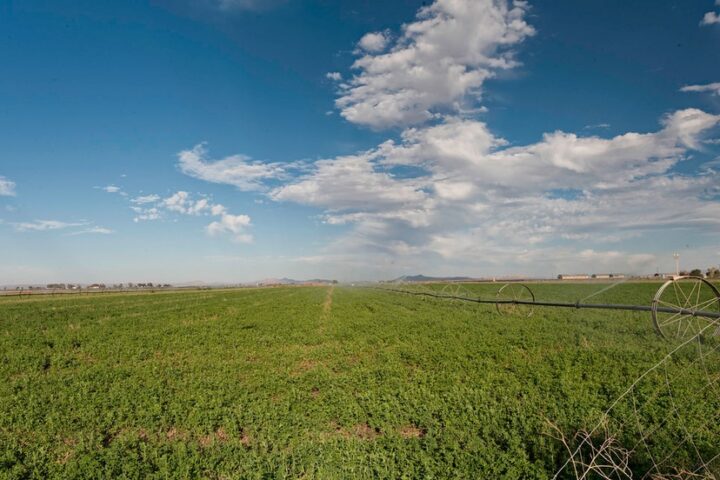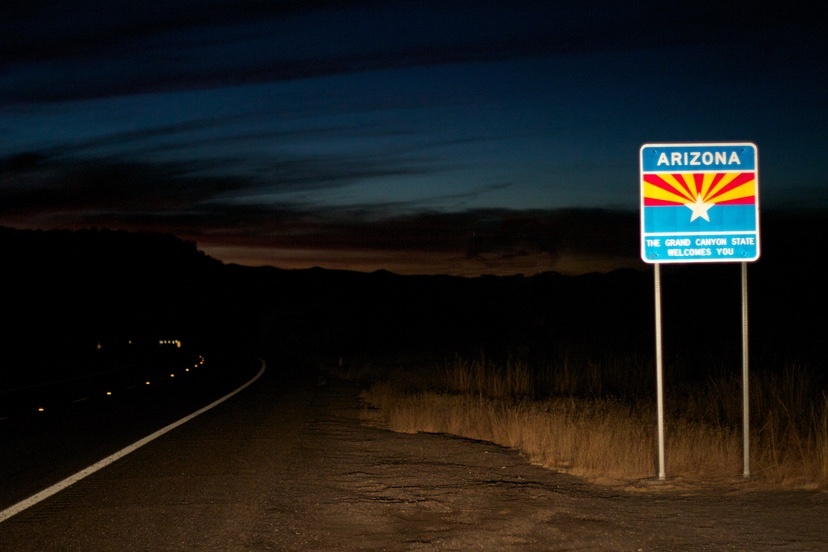As Wayne Wade, former resident of La Paz County, Arizona, explained the situation in a recent radio interview, “Gold is worth quite a bit. Water’s worth more than gold, if you don’t have it…”
A Saudi-owned alfalfa farm has been extracting massive amounts of that liquid gold, in the middle of the Arizona desert, and exporting the hay to Saudi Arabia.
The farm’s water use was first reported about eight years ago by investigative reporters Nate Halverson and Ike Sriskandarajah, and shared by San-Francisco-based Center for Investigative Reporting. The Center updated the story last week in a radio production aired on ‘Reveal’ — a Sunday show broadcast on Ignacio radio station KSUT. You can listen to the audio of the broadcast here.
The water crisis in the American West has only worsened, as megafarms have taken hold.
For more of Halverson’s reporting on the global scramble for food and water, you can watch the documentary film, “The Grab”, directed by Gabriela Cowperthwaite and available to stream starting June 14.
Last week’s show began in La Paz County, Arizona, where local residents are watching their wells run dry as foreign-owned alfalfa farms have spread across the landscape. Ten years ago, Saudi Arabia’s largest dairy company, Almarai, purchased 15 square miles of land in the Arizona desert and converted it into alfalfa fields.
Yes. A dairy based in a Middle Eastern desert is growing hay halfway around the world in another desert, and they’re able to do it due to the presence of an large underground aquifer, where they are able to pump 1700 gallons per minute, due to the lack of groundwater pumping regulations in La Paz County.
The company was basically mining ancient water, an accumulation of water over the eons of time. There is no cost for the water being pumped from the wells, or restrictions on how much they use.
Unlike in Iowa or Nebraska with their idle winters, in the Arizona desert, you can grow hay all year long, assuming you have water.
From the Reveal transcript:
Nate Halverson: Saudi Arabia knows what happens if you farm the desert too long. About 30 years ago, the Saudis began digging deep under the sand for something other than oil.
Elie Elhadj: You’ll bring in enough dollars and find enough water and you’ll grow the desert green until either the dollars become scarce or the water runs out.
Nate Halverson: That’s Elie Elhadj. He’s a former CEO of a major Saudi bank. He also wrote a critical report about Saudi Arabia’s foray into agriculture. He called it ‘Camels Don’t Fly, Deserts Don’t Bloom.’ … With the groundwater, Saudi Arabia became an agricultural powerhouse.
Elie Elhadj: The Saudi desert became the sixth-largest exporter of wheat in the world.
Nate Halverson: Elie says, exporting crops like wheat and hay is the same thing as exporting water… So why would a country with so little water become the world’s sixth biggest exporter of wheat?
Elie Elhadj: Well, frankly, it’s crazy, and time really proved that it was an insane decision.
Nate Halverson: Saudi Arabia has nearly run out of groundwater, and so dairy companies like Almarai have been told to begin growing nearly all their hay in other places like Sudan, Ethiopia, Argentina, and Arizona. All of it will get shipped back home to feed their dairy cows. We reached out to Almarai and the Saudi government for comment on our story, but they declined.
Elie Elhadj: Bottom line is that the current generation sucked the aquifers dry, to deny future generations of their rightful endowment.
At a meeting in 2017, the residents of La Paz County protested that their wells were drying up, and demanded that their county commissioners do something. Commissioner Holley Irwin, a conservative Republican, was motivated to start taking political action to save the rural way of life in La Paz.
She takes Nate Halverson for a drive in the Arizona desert, where one of the world’s most water-thirsty crops is spreading across the landscape.

Holly Irwin: This is all alfalfa. It’s depressing. It really is… Wanted to take you by here, so you could see how much it’s changed.
Nate Halverson: The fields now cover far more land and there’s clusters of giant hay barns scattered for miles. Those didn’t exist the first time I was here in 2015.
A long line of hay trucks are all waiting in line. Semi-trucks with two trailers behind… 30 of them. 60 semi-trailers covered in hay.
Hay is one of the most valuable crops in the U.S. Apparently, Arizona doesn’t track hay exports or their impact on water, but some researchers at the University of Arizona did, and they estimated that in Arizona, the water used to grow exported hay is roughly equivalent to the water used by a million people in Phoenix.
Holly Irwin keeps asking the state’s water department to conduct a hydrologic study — an important study, because it’s the only way to know how much water is being used, how much is left, and how long until it’s gone. Like the water in Saudi Arabia.
But the state water department keeps ignoring her.
Back in 1986, the City of Phoenix started buying up land in La Paz County with the intention of mining the underground water, to help ensure a steady municipal supply. Scottsdale did the same.
But in 2012, Phoenix decides it doesn’t need La Paz water after all, and starts selling the land to a company called International Farming Corporation. IFC is a multi-billion-dollar investment company, and it gets to work drilling bigger, deeper wells to tap into the precious groundwater.
Then IFC leases some of the land to Al Dahra, the other big hay producer in La Paz County. This is not a Saudi company. Al Dahra from the United Arab Emirates.
Water once destined to serve the residents of Phoenix is no longer staying in Arizona. It’s being shipped overseas… in the form of alfalfa.

